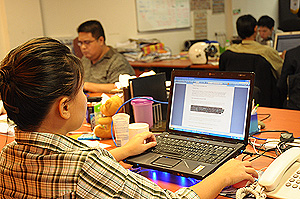Singaporeans may fancy ourselves the most envied nation in the region, but there are some things across the Causeway that make us wide-eyed with wonderment.
Why is it, for example, that the average Malaysian ‘roti canai’ beats even our most highly-rated prata in taste and texture? How in the world did Malaysia end up with the region’s most charismatic budget airline when we’re supposed to be the transport hub of Asia?
 And why, as
Malaysiakini
celebrates its 10th anniversary this weekend in Kuala Lumpur, are we still waiting for a Singaporekini?
And why, as
Malaysiakini
celebrates its 10th anniversary this weekend in Kuala Lumpur, are we still waiting for a Singaporekini?
I am not an expert in food or aviation, but I have been following the ups and downs of Malaysia’s leading independent news website over the years and can hazard a few reasons why Singapore has no equivalent. The theory you’ll most commonly hear is that Internet laws in Singapore are more restrictive.
In fact, the legal minefields in the two countries are basically similar. Indeed, the Malaysian government has been more trigger-happy than its Singapore counterpart with laws such as the Internal Security Act and Sedition Act. What's more, it would be an insult to Malaysia’s activists to say that they are more active only because they face less risk. The ones I know don’t equate what is permissible with what is possible.
Three reasons
Instead, there are at least three more credible reasons why, compared with Malaysiakini , Singapore’s alternative media are still so ‘kampung’.
First, Malaysiakini benefits from the country’s more pluralistic politics, including a fractured political elite, strong opposition parties and energetic civil society organisations. These diverse forces ensure that the supply side of political news never runs dry.
Their unrestrained, unpredictable contests make political news as gripping as the tautest thriller and as melodramatic as a soap opera. In contrast, a Singaporekini would be, most weeks, about as compelling as a commercial for detergent.
Second, Malaysiakini has been able to count on both domestic and foreign support that is not available to wannabes in Singapore. Domestically, Malaysiakini is embedded in networks of solidarity with various well-organised pro-democracy groups such as Suaram and the Centre for Independent Journalism.
They don't always see eye to eye, but they do make up a broad social movement that has no equivalent in Singapore. Malaysiakini’s overseas funding would also be tough to replicate in Singapore. Under the Political Donations Act, the government could ban overseas funding for a Singaporekini simply by gazetting it as a political association.
Third, Malaysiakini’s success has been built mainly on the mainstream media’s failure. Founders Steven Gan and Premesh Chandran are not media superstars. They are simply competent, courageous, creative and conscientious journalists like thousands of their fellow professionals around the world.
In Malaysia, however, they shine because their peers in the mainstream media are so smothered by government. Singapore’s mainstream media are also subordinate to the government, but there is a difference in degree that produces qualitatively different outcomes.
At critical moments in Malaysia, government control did not just strain press credibility, it tore it up, crushed it underfoot and set it on fire for all to see, causing a mass exodus to alternative media. In Singapore, the likes of The Online Citizen might reach the heights of Malaysiakini if The Straits Times were forced to stoop as low as The New Straits Times.
Could all this change? Could a Singaporekini match Malaysiakini ? Anything is possible. But, the odds are slightly higher of our ‘roti prata’ becoming as good as their ‘roti canai’.
CHERIAN GEORGE ([email protected]) is an academic at the Nanyang Technological University, Singapore. He blogs at www.journalism.sg . A fuller study of Malaysiakini can be found in his 2006 book, ‘Contentious Journalism and the Internet’ .

